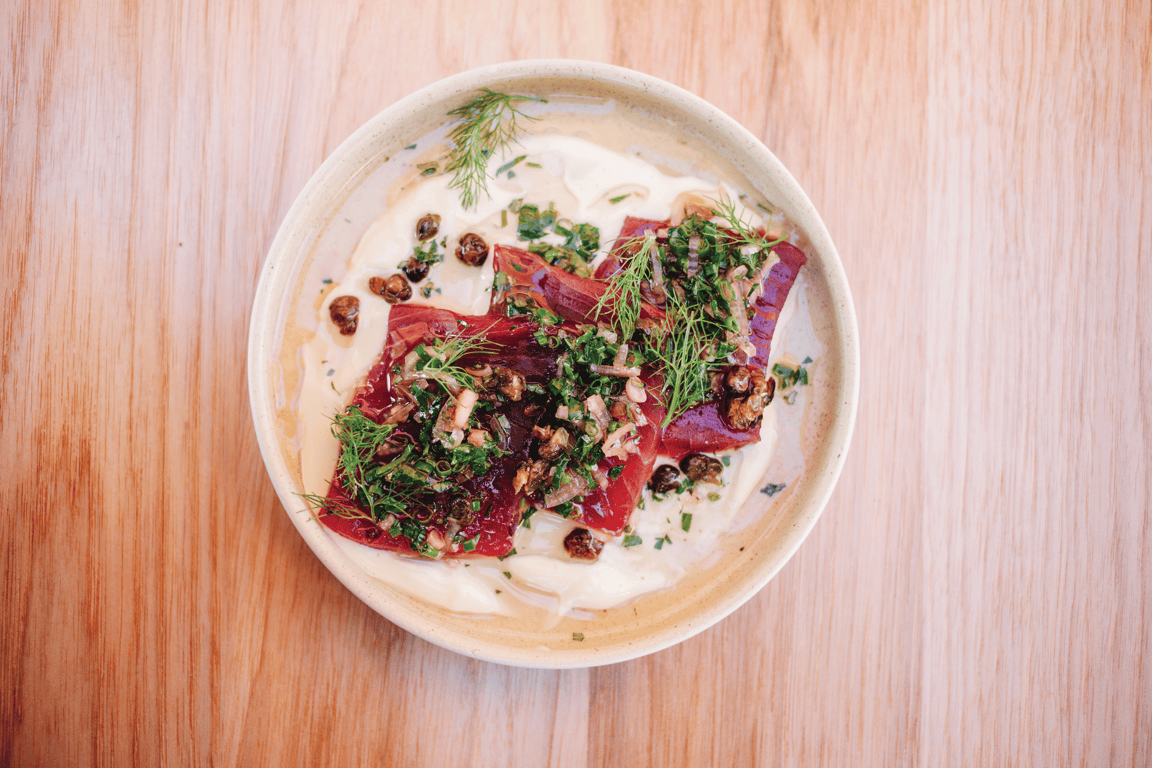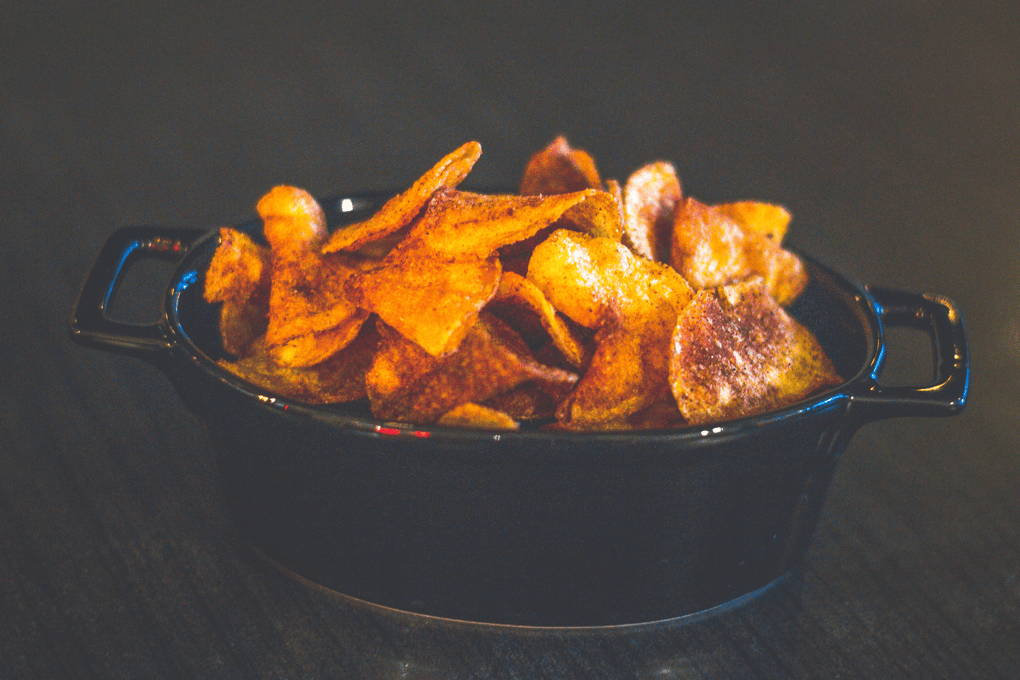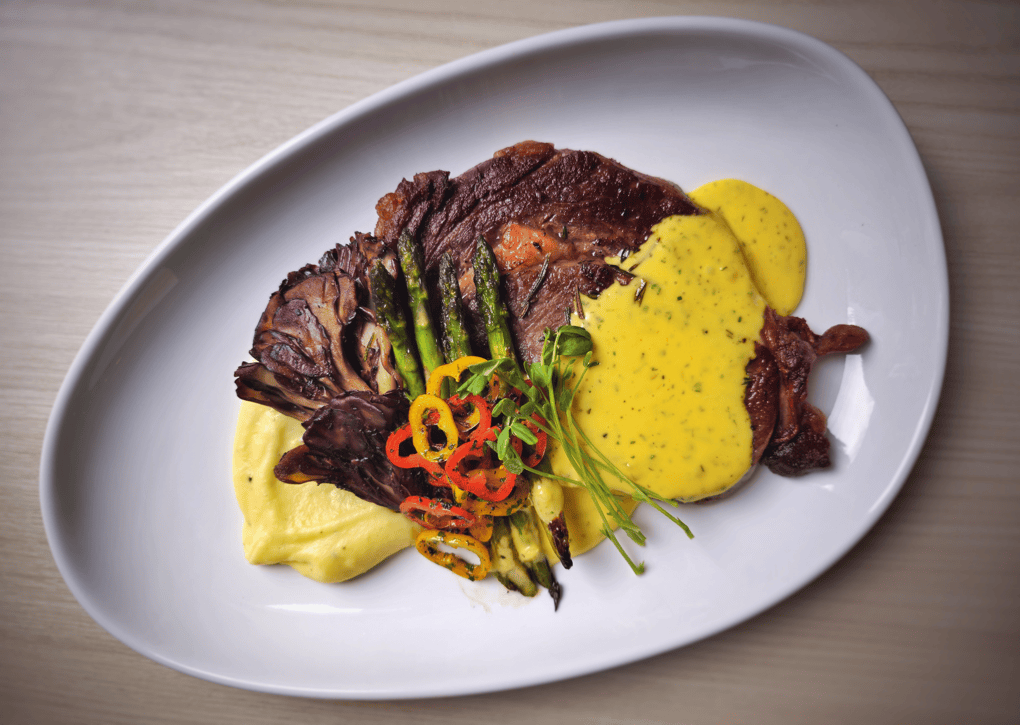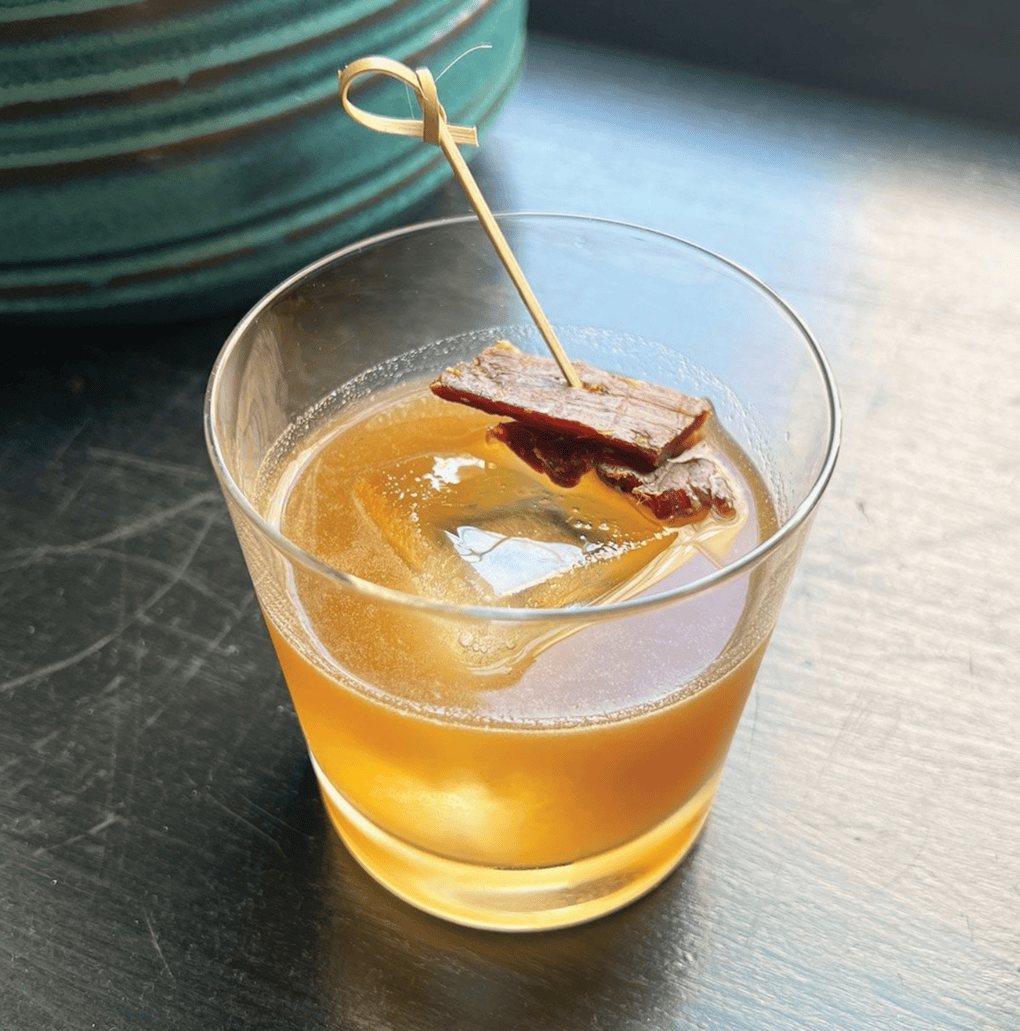
Tallow’s Renaissance
This heritage ingredient brings big possibilities to the modern table
Tallow’s Renaissance
This heritage ingredient brings big possibilities to the modern table
By Katie Ayoub
February 7, 2024
By Katie Ayoub
February 7, 2024
It’s a good day in menu development when fat is trending. After all, fat is flavor. Today, chefs and mixologists are calling on tallow, that luscious ingredient made from rendered beef fat, using it as a flavor builder and premium callout with everything from fries and vegetable sides to sauces, vinaigrettes and cocktails. Tallow is not new; it’s a throwback ingredient hailing from the culinary traditions of a number of locales, including the American South, Great Britain, Australia, Latin America, the Middle East and China. Now, a number of drivers are moving tallow into prominence, opening the door to a world of modern menu ideas.
“Tallow’s newfound positioning connects to the larger movement of fat in general making a comeback,” says Nikki Freihofer, strategy director, The Culinary Edge. “The pendulum always swings every few decades between demonizing carbs and demonizing fats. Right now, fat is good. Tallow fits nicely with modern consumer interest and demands. Today’s consumers are savvy, asking more questions about menu items and where they come from.”
Natural and minimally processed are key values that today’s consumers seek, and tallow ticks both boxes. Giving even more lift to the trend are the lifestyle diets that specifically extol the virtues of tallow, including paleo and keto. “There’s a cultural shift toward appreciating a more primal way of eating,” says Kathy Casey, owner, chef and mixologist, Kathy Casey Food Studios-Liquid Kitchen. “This involves a return to whole foods, and tallow, being a traditional cooking fat, aligns with this preference. Tallow fits well into popular diets such as keto, where high-fat consumption is necessary. There’s also a recent trend in avoiding certain cooking oils, particularly those derived from seeds. As an animal-based fat, tallow is seen by many as a healthier alternative.”
Another driver pushing tallow into focus is a pendulum swing of a different sort. “With all the focus on plant-based eating, inevitably, we’re going to see an anti-trend, and animal fat is as anti-vegan as you’re going to get,” says Maeve Webster, president of Menu Matters consultancy. “Also, psychologically, consumers are ready for it. They’ve been compromising, inconvenienced and generally upset over the last several years. Indulging in rich, fatty and luxurious ingredients feels decadent and is wholly permissible right now.”

Elevate pub food offerings with tallow. Here, hand-cut russet potatoes are twice-fried in Wagyu beef tallow.
Culinary Advantage
With these forces lending momentum to tallow, its opportunity is significant, leading with rich flavor, a high smoke point and lush mouthfeel. “Tallow is malleable; it can be molded into so many different things,” says Webster. “It is unique, unexpected and certainly very different from what we’ve seen.” Today, chefs and beverage developers are exploring the possibilities. Panzano in Denver flavors its whipped tallow butter with rosemary, serving it with the restaurant’s Housemade Focaccia. At Lapeer Steak & Seafood in Alpharetta, Ga., the prime N.Y. strip gets a glorious crown of smoked tallow butter. It’s made by rendering beef trim, slow cooking it, folding in butter and then cold smoking to infuse flavor. Once it fully solidifies, a bit of salt is added. “It’s a great practice to reduce waste while stretching out maximum beef flavor,” says Blake Hartley, culinary director of Maven, Lapeer Steak & Seafood’s restaurant group.
Tallow enriches sauces and vinaigrettes, introducing silky complexity. “Chefs who are looking for that depth of umami should play with tallow, maybe adding it to a demi-glace or searing steak in tallow instead of oil, boosting the flavor of the meat,” says Dan Coudreaut, chef/owner of Lantern Pizza Co. and former executive chef and VP of culinary innovation at McDonald’s. “However you would use duck fat, you could use tallow. If you do a confit, maybe do a beef confit with tallow—that could be really interesting. Or how about a steakhouse burger with a pretzel bun brushed with tallow? That could be magic.”
 Photo Credit: Mad Honey Culinary Studio
Photo Credit: Mad Honey Culinary Studio For his Skillet-Seared Aussie Beef Ribeye with maitakes and black truffle-Parmesan mashed potatoes, Mad Honey Culinary Studio’s Ian Ramirez dials up flavor with an umami-rich Béarnaise made with tallow, bone marrow and butter.
Ian Ramirez, owner of Mad Honey Culinary Studio, a culinary strategy consultancy, is a tallow evangelist, singing its praises as an effective fat. “Tallow is a great fat to make sauces like Béarnaise and hollandaise,” he says. His Skillet-Seared Aussie Beef Ribeye with maitake mushrooms and black truffle-Parmesan Yukon mashed potatoes features a Béarnaise made with tallow, bone marrow and butter. “The inspiration came from my appreciation for tallow making. I always love having it in my pantry because there are a lot of things you can do with it. And, when you’re paying for beef by the pound, you want to get every last penny out.”
Kathy Casey suggests tapping into tallow’s enriching qualities by heating, then infusing with garlic and fresh herbs and using it to baste dishes to produce a luxuriant mouthfeel. “Rather than traditional butter, infused tallow would work well over seared fish or steamed shellfish—using menu verbiage, of course, to make the guest aware of the ingredient,” she says.
Joe Flamm, executive chef/owner of Chicago’s Rose Mary, uses tallow in a surprising application, adding intrigue and uniqueness to a starter. His Tuna Crudo is topped with a beef fat-shallot vinaigrette, veal aïoli and crispy capers. Tallow can also inform veg-centric builds, adding that much-needed crave factor. At the Brick Store Pub in Decatur, Ga., beef tallow flavors the Skillet Roasted Vegetables. “Tallow offers diners a quality cue and carries a premium pub identity that’s really indulgent and delicious,” adds Freihofer.
Tallow is also making a play in the beverage space, delivering its lush mouthfeel through fat-washing, a trend that has flourished in recent years. At Death & Taxes in Raleigh, N.C., the Out to Pasture cocktail is tallow-washed and features bourbon, sweet vermouth and allspice. A beef jerky garnish nicely ups the meat ante.
 Photo Credit: Death & Taxes
Photo Credit: Death & Taxes At Death & Taxes in Raleigh, N.C., the tallow-washed Out to Pasture cocktail features bourbon, sweet vermouth and allspice; garnished with beef jerky.
TikTok You Don’t Stop
Perhaps the most decadent use of tallow is the edible candle, lit tableside and served with warm bread. As it melts, diners dip the bread in the lush liquid. Although it’s not a wholly novel offering, TikTok has breathed new life into this interactive presentation, helping demystify tallow and showcase its indulgent side. Steakhouse Alpen Rose in Philadelphia offers a prime example of this Insta-ready application with its Wagyu Tallow Candle with roasted garlic purée, sea salt and warm dipping bread.
Social media has thrown a spotlight on tallow, particularly with explainer videos of the Sichuan hot pots viral phenomenon, often calling out tallow as the “soul of the hot pot.” Da Long Yi, a Chinese hot pot concept with two locations in New York and more than 2,000 restaurants worldwide, serves as a champion here, featuring tallow in a number of rich, savory broths on offer.
Incorporating tallow on modern menus gives operators fertile ground for evocative storytelling. “There are so many cultural stories to be told about tallow, if operators choose to go that way,” says Maeve Webster. “You can also tout origin stories, noting whether it’s grass-fed or comes from a specific cattle breed. Adding narrative dials up the premium factor and piques interest in this heritage ingredient.”
It’s a good day in menu development when fat is trending. After all, fat is flavor. Today, chefs and mixologists are calling on tallow, that luscious ingredient made from rendered beef fat, using it as a flavor builder and premium callout with everything from fries and vegetable sides to sauces, vinaigrettes and cocktails. Tallow is not new; it’s a throwback ingredient hailing from the culinary traditions of a number of locales, including the American South, Great Britain, Australia, Latin America, the Middle East and China. Now, a number of drivers are moving tallow into prominence, opening the door to a world of modern menu ideas.
“Tallow’s newfound positioning connects to the larger movement of fat in general making a comeback,” says Nikki Freihofer, strategy director, The Culinary Edge. “The pendulum always swings every few decades between demonizing carbs and demonizing fats. Right now, fat is good. Tallow fits nicely with modern consumer interest and demands. Today’s consumers are savvy, asking more questions about menu items and where they come from.”
Natural and minimally processed are key values that today’s consumers seek, and tallow ticks both boxes. Giving even more lift to the trend are the lifestyle diets that specifically extol the virtues of tallow, including paleo and keto. “There’s a cultural shift toward appreciating a more primal way of eating,” says Kathy Casey, owner, chef and mixologist, Kathy Casey Food Studios-Liquid Kitchen. “This involves a return to whole foods, and tallow, being a traditional cooking fat, aligns with this preference. Tallow fits well into popular diets such as keto, where high-fat consumption is necessary. There’s also a recent trend in avoiding certain cooking oils, particularly those derived from seeds. As an animal-based fat, tallow is seen by many as a healthier alternative.”
Another driver pushing tallow into focus is a pendulum swing of a different sort. “With all the focus on plant-based eating, inevitably, we’re going to see an anti-trend, and animal fat is as anti-vegan as you’re going to get,” says Maeve Webster, president of Menu Matters consultancy. “Also, psychologically, consumers are ready for it. They’ve been compromising, inconvenienced and generally upset over the last several years. Indulging in rich, fatty and luxurious ingredients feels decadent and is wholly permissible right now.”

Elevate pub food offerings with tallow. Here, hand-cut russet potatoes are twice-fried in Wagyu beef tallow.
Culinary Advantage
With these forces lending momentum to tallow, its opportunity is significant, leading with rich flavor, a high smoke point and lush mouthfeel. “Tallow is malleable; it can be molded into so many different things,” says Webster. “It is unique, unexpected and certainly very different from what we’ve seen.” Today, chefs and beverage developers are exploring the possibilities. Panzano in Denver flavors its whipped tallow butter with rosemary, serving it with the restaurant’s Housemade Focaccia. At Lapeer Steak & Seafood in Alpharetta, Ga., the prime N.Y. strip gets a glorious crown of smoked tallow butter. It’s made by rendering beef trim, slow cooking it, folding in butter and then cold smoking to infuse flavor. Once it fully solidifies, a bit of salt is added. “It’s a great practice to reduce waste while stretching out maximum beef flavor,” says Blake Hartley, culinary director of Maven, Lapeer Steak & Seafood’s restaurant group.
Tallow enriches sauces and vinaigrettes, introducing silky complexity. “Chefs who are looking for that depth of umami should play with tallow, maybe adding it to a demi-glace or searing steak in tallow instead of oil, boosting the flavor of the meat,” says Dan Coudreaut, chef/owner of Lantern Pizza Co. and former executive chef and VP of culinary innovation at McDonald’s. “However you would use duck fat, you could use tallow. If you do a confit, maybe do a beef confit with tallow—that could be really interesting. Or how about a steakhouse burger with a pretzel bun brushed with tallow? That could be magic.”
 Photo Credit: Mad Honey Culinary Studio
Photo Credit: Mad Honey Culinary Studio For his Skillet-Seared Aussie Beef Ribeye with maitakes and black truffle-Parmesan mashed potatoes, Mad Honey Culinary Studio’s Ian Ramirez dials up flavor with an umami-rich Béarnaise made with tallow, bone marrow and butter.
Ian Ramirez, owner of Mad Honey Culinary Studio, a culinary strategy consultancy, is a tallow evangelist, singing its praises as an effective fat. “Tallow is a great fat to make sauces like Béarnaise and hollandaise,” he says. His Skillet-Seared Aussie Beef Ribeye with maitake mushrooms and black truffle-Parmesan Yukon mashed potatoes features a Béarnaise made with tallow, bone marrow and butter. “The inspiration came from my appreciation for tallow making. I always love having it in my pantry because there are a lot of things you can do with it. And, when you’re paying for beef by the pound, you want to get every last penny out.”
Kathy Casey suggests tapping into tallow’s enriching qualities by heating, then infusing with garlic and fresh herbs and using it to baste dishes to produce a luxuriant mouthfeel. “Rather than traditional butter, infused tallow would work well over seared fish or steamed shellfish—using menu verbiage, of course, to make the guest aware of the ingredient,” she says.
Joe Flamm, executive chef/owner of Chicago’s Rose Mary, uses tallow in a surprising application, adding intrigue and uniqueness to a starter. His Tuna Crudo is topped with a beef fat-shallot vinaigrette, veal aïoli and crispy capers. Tallow can also inform veg-centric builds, adding that much-needed crave factor. At the Brick Store Pub in Decatur, Ga., beef tallow flavors the Skillet Roasted Vegetables. “Tallow offers diners a quality cue and carries a premium pub identity that’s really indulgent and delicious,” adds Freihofer.
Tallow is also making a play in the beverage space, delivering its lush mouthfeel through fat-washing, a trend that has flourished in recent years. At Death & Taxes in Raleigh, N.C., the Out to Pasture cocktail is tallow-washed and features bourbon, sweet vermouth and allspice. A beef jerky garnish nicely ups the meat ante.
 Photo Credit: Death & Taxes
Photo Credit: Death & Taxes At Death & Taxes in Raleigh, N.C., the tallow-washed Out to Pasture cocktail features bourbon, sweet vermouth and allspice; garnished with beef jerky.
TikTok You Don’t Stop
Perhaps the most decadent use of tallow is the edible candle, lit tableside and served with warm bread. As it melts, diners dip the bread in the lush liquid. Although it’s not a wholly novel offering, TikTok has breathed new life into this interactive presentation, helping demystify tallow and showcase its indulgent side. Steakhouse Alpen Rose in Philadelphia offers a prime example of this Insta-ready application with its Wagyu Tallow Candle with roasted garlic purée, sea salt and warm dipping bread.
Social media has thrown a spotlight on tallow, particularly with explainer videos of the Sichuan hot pots viral phenomenon, often calling out tallow as the “soul of the hot pot.” Da Long Yi, a Chinese hot pot concept with two locations in New York and more than 2,000 restaurants worldwide, serves as a champion here, featuring tallow in a number of rich, savory broths on offer.
Incorporating tallow on modern menus gives operators fertile ground for evocative storytelling. “There are so many cultural stories to be told about tallow, if operators choose to go that way,” says Maeve Webster. “You can also tout origin stories, noting whether it’s grass-fed or comes from a specific cattle breed. Adding narrative dials up the premium factor and piques interest in this heritage ingredient.”
About the Author
![]() Katie Ayoub serves as managing editor of Flavor & The Menu and content strategist for the Flavor Experience, an annual conference geared toward chain operators. She is president of Katie Ayoub & Associates, serving up menu trends expertise, content creation and food & beverage consultancy. Based in Chicago, Katie has been working in foodservice publishing for more than 20 years and part of the Flavor team since 2006. [email protected]
Katie Ayoub serves as managing editor of Flavor & The Menu and content strategist for the Flavor Experience, an annual conference geared toward chain operators. She is president of Katie Ayoub & Associates, serving up menu trends expertise, content creation and food & beverage consultancy. Based in Chicago, Katie has been working in foodservice publishing for more than 20 years and part of the Flavor team since 2006. [email protected]







